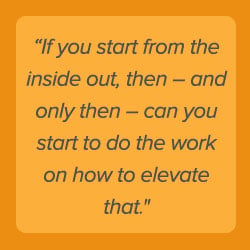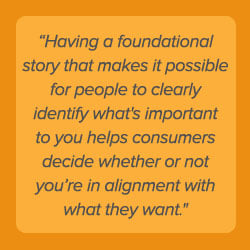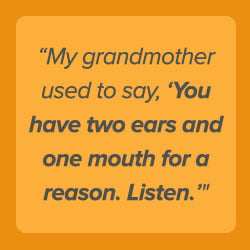Jay Wilkinson, founder and CEO of Firespring, a Nebraska-based marketing and software company with a purpose to leverage their people, products and profit as a force of good, recently joined the QSR Nation Podcast to discuss the importance of branding and building a brand storyline.
Below is Part 1 of 2 summarizing what they discussed. For the full podcast episode (#089), visit pfsbrands.com/qsr-nation-podcast.
From your perspective, why do you think it’s important to have solid branding for any business?
Wilkinson: Establishing a compelling brand is the first step and really the core foundational exercise in who you are, what you stand for, why you are who you are, and why you want to be a brand that people want to align themselves with.
I’ve spoken with many companies that exist more for their why than their what. But it’s not like they can one day say, “hey, let's come up with a brand that makes it look like we care about the environment” while they’re spewing sewage into the canal behind the business. Today’s world doesn’t work that way, especially when there are sites like Glassdoor and Yelp that shine a light into your business and leave no room for hiding.
 In my opinion, the first step to establishing a solid brand is to start by looking from the inside out and to make sure that you establish a truly genuine and sincere principle. Whether it's in the lives of your employees, in the lives of the customers you serve or by elevating humanity in some way, start there. If you start from the inside out, then – and only then – can you start to do the work on how to elevate that.
In my opinion, the first step to establishing a solid brand is to start by looking from the inside out and to make sure that you establish a truly genuine and sincere principle. Whether it's in the lives of your employees, in the lives of the customers you serve or by elevating humanity in some way, start there. If you start from the inside out, then – and only then – can you start to do the work on how to elevate that.
What are a few ways to start to begin understanding what your purpose is?
Wilkinson: You can invite your customers and the advocates of your brand to become part of your story, you can connect with them about the things that they care about and you can tell stories about the people you serve. There are so many ways to pull the important customers and the brand advocates into your brand's story but it always starts with the why.
But isn’t a business ultimately about making money? Why is building a brand story so important?
Wilkinson: I think despite what Mr. Wonderful says on Shark Tank, it is not all about the money and it's not all about the profit. I think the minute any customer feels that your brand is all about money, they are going to go another direction. It's becoming more and more evident every year that goes by, that companies and brands must make sure they are aligned with positive outcomes that their potential customers want to see.
Authenticity also plays a big role. It's kind of sad, I feel that word "authenticity" has been used in so many articles and discussions, that it’s more of a buzzword than a legitimate concept. The essence behind what we mean by authenticity is absolutely dead on and important for any brand.
What are some of the pivotal aspects of building a brand storyline?
 Wilkinson: The first aspect is being really clear as to what your foundational elements are. I'm a huge believer in the movements such as B Corporation, Conscious Capitalism and 1% for the Planet. These help identify, from a consumer perspective, the aspect of your brand that is in alignment with what they're looking for. Whether or not an organization becomes a member of the one of these institutions isn't the important part, it's about the foundational elements of what those different movements stand for.
Wilkinson: The first aspect is being really clear as to what your foundational elements are. I'm a huge believer in the movements such as B Corporation, Conscious Capitalism and 1% for the Planet. These help identify, from a consumer perspective, the aspect of your brand that is in alignment with what they're looking for. Whether or not an organization becomes a member of the one of these institutions isn't the important part, it's about the foundational elements of what those different movements stand for.
Having a foundational story that makes it possible for people to clearly identify what's important to you helps consumers decide whether or not you’re in alignment with what they want. At Firespring, our purpose as a business is to leverage our people, our products and our profit as a force for good. We do that through our “Power of 3 Program”:
- We give one percent of our top line revenue to the Firespring Foundation, which supports nonprofits throughout our region.
- We give two percent of our products away by supporting (through giving thousands of dollars, support and marketing each year) to three nonprofit organizations.
- We give three percent of our people by allowing every single employee in our business (200+) to go out into the community and volunteer for one full day each month. We don't tell them who to volunteer for, they choose something that aligns with them personally.
We have a story and a starting point from where we can share our “Power of 3” that will resonate with the clients we serve. It also gives us a framework and the guide rails by which we can take that story and elevate it in so many different ways. I think it’s important to have a foundational description of the purpose of the business, expressed in a way that is easy to understand. Then, all of our marketing and awareness efforts around our products and services to others is going to incorporate that baseline foundational element of our purpose.
How do you take that model and transfer it into a franchise brand such as Champs Chicken so that the customer feels like they're a part of something greater than just a purchase?
Wilkinson: I will say, franchising is how I got my start in business – and I will tell you the number one thing that I did that separated my franchise from the pack, was the concept of R&D which obviously stands for “Rip Off” and “Duplicate.” When I started up my franchise back in the 90’s, I traveled all across the United States and visited more than a hundred fellow franchise owners in my system. In the three months leading up the opening of my store, I (without warning) met for just a half hour with these owners and asked them what’s the best thing they’ve done, worst thing they’ve done, what they would do differently if they could go back to the beginning and start over, etc.
 Ultimately, my store ended up being the fastest growing location in franchise in history (at the time) and it hit $1 million dollars in annualized revenue faster than any store in that franchise's history. I attribute a hundred percent of that to the fact of, like my grandmother used to say, "You have two ears and one mouth for a reason. Listen."
Ultimately, my store ended up being the fastest growing location in franchise in history (at the time) and it hit $1 million dollars in annualized revenue faster than any store in that franchise's history. I attribute a hundred percent of that to the fact of, like my grandmother used to say, "You have two ears and one mouth for a reason. Listen."
This whole prospect of learning best practices from others is to be valued. I think too many of us think we need to innovate, to create something out of thin air and to make something up – and I don't believe that's necessary.
With the franchises I still have today, we differentiate ourselves by making a very deliberate effort to change the customer experience inside the store and to make sure that every single team member feels pride in being part of that brand. We're constantly trying to compare ourselves to how other stores in our system are doing so that our team members know that they stand head and shoulders above the examples set in other areas.
It’s fascinating what strong leadership can do to the in-store feeling that people have when they walk into a place where the team members really care about the work that they're doing rather than just punching the clock. Because of this, I always go back to operational issues first before marketing because that's the foundation of good marketing – charting what happens with the experience inside.
It’s amazing how much leadership can drive employees to be better just through watching a great leader. How does that relate to branding?
Wilkinson: Going back to that concept of the brand story, it’s important to note that making customers the hero of the story rather than making yourself the hero of the story is a key component of a good brand strategy. In marketing efforts it’s important to figure out how to make your customers the hero because that's what appeals and resonates with them, rather than trying to make your business the hero.
I always say that “Story without strategy is art and story with strategy is marketing.” If you're thinking about telling stories and you have the strategy behind it, that's what marketing is.

